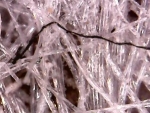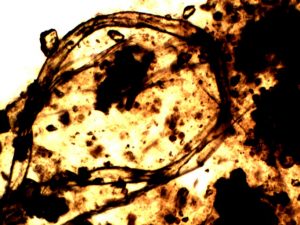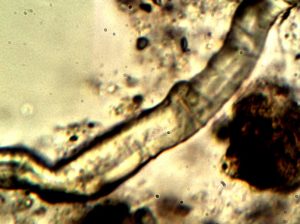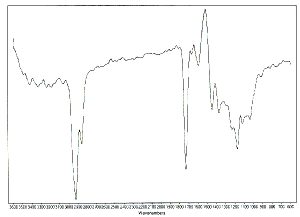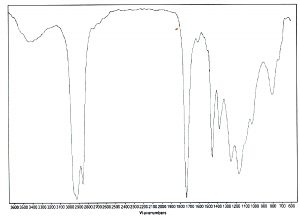A Point of Reckoning:
Part I
by
Clifford E Carnicom
Aug 19 2017
Edited Aug 21 2017
Edited Aug 25 2017
| Note: Carnicom Institute is not offering any medical advice or diagnosis with the presentation of this information. CI is acting solely as an independent research entity that is providing the results of extended observation and analysis of unusual biological conditions that are evident. Each individual must work with their own health professional to establish any appropriate course of action and any health related comments in this paper are solely for informational purposes. |

A general equivalency between the organic nature of materials collected with the use of HEPA (High Efficiency Particulate Arrestance) air filters (indoor and outdoor) and a series of concentrated rain samples has been established. This conclusion is based upon the use of infrared analysis, microscopic examination, and visual examination of the materials. The inherent similarity between the historically designated “environmental filament” and the filaments known to be clearly associated with the so-called “Morgellons” condition must also be accepted as a part of this analysis.
This more recent work has been conducted over a period of roughly two years with careful repetitions and redundancies. Fundamentally, the conclusion is logical but nevertheless sweeping in impact; what is in the air is in the water. Furthermore, what is in the air and the water has an important relationship to marked changes in health that affect the general public. What is in the air and in the water is in our bodies. This state has developed in a global and ubiquitous sense for more than two decades, and we must now all share some responsibility to acknowledge and proclaim our condition on the planet.
The details of the methods will only be briefly summarized here; they involve long term sample collection and a variety of laboratory analyses over extended time. The photographs below will demonstrate the essence of comparison.
The similarity of the infrared plots reveals to us that the basic organic structure of the extracted materials from the air filters and the rain samples are the same. The details of molecular structure inherent within the plot will be reserved for future discussion; the signature aspect of infrared spectroscopy is sufficient at this point to advance the argument.
In addition, microscopic examination reinforces that the air and rainfall biological filament samples are identical. There is little doubt that this biological equivalency is also at the root of the infrared analysis of organics mentioned above.
Additional notes on some of the details of sample types and preparation follow at the end of this report.
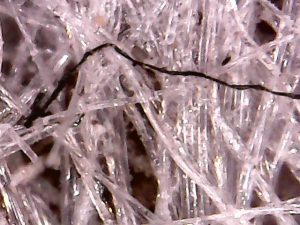 |
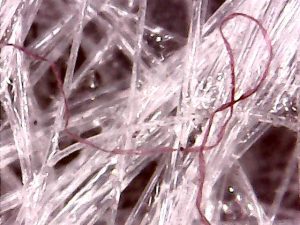 |
|
Representative “environmental” filaments collected on indoor HEPA Air filter |
|
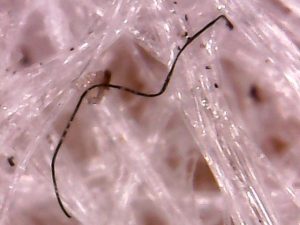 |
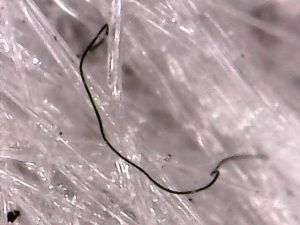 |
| Indoor – Outdoor HEPA Air Filter Comparisons: Representative “environmental” filaments also collected on an outdoor air HEPA filter under forced air. These filaments were collected within a 24 hour exposure to a new filter element. Results are identical between indoor and outdoor exposures. Magnification Approx 150x. |
|
|
Magnification Approx. 1500x |
Magnification Approx. 5000x. |
|
Filaments collected from rainwater concentrate sample.
|
|
 |
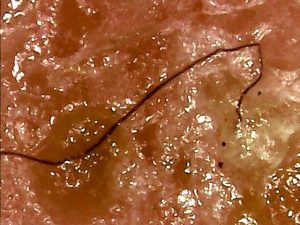 |
| Observed skin that exhibits symptoms characteristic of the Morgellons condition. |
Filament sample recorded (one of several) within a portion of the skin condition shown to the left. Magnification approx. 150x. |
|
Infrared Plot of HEPA Air Filter Extract |
Infrared Plot of Rainwater Concentrate Sample |
|
Infrared plots to compare the organic nature of the |
|
Additional notes:
HEPA Filter(s):
HEPA filters are air filters that are quite effective at trapping materials to the micron size level. They have an interesting history and origin, as they were developed as a part of the Manhattan Project in the 1940’s to trap radioactive materials. This filter type is now in common use and affordable. There is a fair amount of usage of HEPA filters in the history of Carnicom Institute (CI) research, as they are a very effective means of collecting air particulates.
They are also used in commercial aircraft. One of the ironies of the aerosol investigations over the last two decades is that a ready source of sample collection material has always existed; the difficulty is that of access to the samples. CI has long advocated that designing any single aircraft test for sampling the atmosphere is an inefficient, deficient, unnecessary and expensive approach to acquire information about the state of pollution in the atmosphere. This singular test approach has been advocated fruitlessly by several parties over the course of time. The situation is that a massive collection of particulate samples already exists for examination and analysis, but that access to it is not forthcoming. On a hearsay basis, there is information to indicate that the disposal of the filters is carefully controlled (potentially designated as radioactive?).
It is also of interest to mention that, at a very early point of the research, I was given anonymous access in confidence to such a filter from a commercial airliner, along with a laboratory test of the filter for certain metallic elements. That individual remains unknown but he remains deserving of thanks from all of us. To my knowledge, there is no similar test by a member of the public since that time, apparently due to the access issues mentioned above.
That particular filter did show unusual levels of barium in the test results (and calcium to my recollection), and it was one of the harbingers of testing for atmospheric metals that was to follow. At the time of receipt, no laboratory facilities of any kind were available to CI and the physics of the aerosol operations were unknown to the level acquired during subsequent research over the years. Credit is also overdue to AC Griffith, now deceased, for his early role in stimulating interest in the electromagnetic aspects of the aerosol issue. The interplay between ionizable materials and electromagnetics subsequently became a dominant theme of CI research, and the contributions of both of these individuals are to be recognized in that history.
In the case of the current research, two indoor and one outdoor HEPA filters have been examined. The indoor filters were exposed to long term collection (6-12 months) and the outdoor filter is exposed under short term forced air conditions. Laboratory testing depends upon the sensitivity of the instruments employed and with that sensitivity comes cost. One of the methods of compensating for decreased sensitivity is to allow for an increased time of collection. This is the preference here. As such, one indoor filter was allowed to run its course for approximately 6 months, and the second indoor filter ran close to one full year. All filters are operated approximately 20 feet above ground level. The history of work includes the use of additional outdoor HEPA filters.
Some of the larger pollutants, e.g., the filament samples, can appear quite readily subject to the microscope. The longer term goal in this project was to collect the micron size material that is invisible to the eye until sufficient mass has been collected. This is the source for chemical and spectroscopic testing in this case.
Sample preparation for instrument use is one of the greatest demands in the laboratory environment. It consumes far more effort and time than most people recognize, other than by those involved in the field. In the case of infrared (IR) spectrometry, water is the bane of the testing process and is generally to be avoided in all respects. The HEPA particulates in this case have been dissolved into ethanol, which is a suitable solvent for the preliminary overview that is covered here. The evaporation of the solvent on a suitable substrate will allow the formation of a film which is well suited to infrared spectroscopy. The IR spectra acquired serves two primary purposes:
- It serves as a unique fingerprint of the compound(s) in solution
- It serves as a useful tool for introductory examination of the molecular structure of the compound(s) in solution
In the case of this paper, the emphasis is only upon the signature aspect of the spectra, as the purpose here is to compare to sampling from a different environment, namely, that of rainfall. This comparison is what is shown above and the point of equality or high similarity is made in the process.
Rainfall Sample:
Rainfall presents even greater difficulties in the sample prep arena. The sensitivity issue discussed above is front and center, and the solution to the problem in this case is to acquire a greater volume of rainfall. Adequate sample volume is definitely an issue, and fortuitous periods of rain will be required. Non-detrimental evaporation and condensing of the sample will require a fair amount of patience, but it can be accomplished. The samples of this paper were collected in 2016 and were condensed to roughly 5% of their original volume.The organic materials were then removed from the water using a non-polar solvent extraction method for subsequent infrared analysis. Additional extensive studies were completed on these samples in the previous year, and they have been recorded in a series of papers on this site.
Clifford E Carnicom
Aug 19 2017
Edited Aug 21 2017
Edited Aug 25 2017
Born Clifford Bruce Stewart
Jan 19 1953

